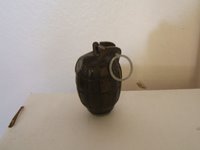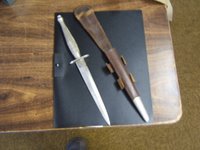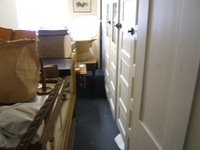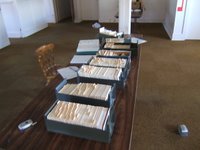 These are two World War II gasmasks. The adult version is quite common, but the child’s mask is much rarer. Called a “Mickey Mouse” gas mask in the old catalogue, it was meant for children 5 and under. The accompanying box has a strap which would have been worn around the child’s neck, making the mask readily at hand in case of a Nazi gas attack.
These are two World War II gasmasks. The adult version is quite common, but the child’s mask is much rarer. Called a “Mickey Mouse” gas mask in the old catalogue, it was meant for children 5 and under. The accompanying box has a strap which would have been worn around the child’s neck, making the mask readily at hand in case of a Nazi gas attack.This week, among many other things, I have been focussing on the extensive collection of military artefacts from the Gananoque Museum Collection. The local Legion b
 ranch is planning their annual Remembrance Day Ceremonies, and I hope some of these items may prove useful to them and their displays. I have only scratched the surface of what is actually there, focusing on the smaller things, hats, medals etc. before moving on to the many uniforms and larger pieces. Keeping track of all these small items will be one of the first considerations.
ranch is planning their annual Remembrance Day Ceremonies, and I hope some of these items may prove useful to them and their displays. I have only scratched the surface of what is actually there, focusing on the smaller things, hats, medals etc. before moving on to the many uniforms and larger pieces. Keeping track of all these small items will be one of the first considerations. Being that the collection is housed in the back room and attic of the Gananoque Chamber of Commerce, I’ve had to take great care while removing theses pieces. Gananoque is very much reliant on our visitors having a pleasant stay, and emerging, dust coated from a back room carrying a Mark 1 hand grenade or an artillery sabre may give people the wrong idea. My exits usually coincide with a lull in traffic; timing is everything.
Being that the collection is housed in the back room and attic of the Gananoque Chamber of Commerce, I’ve had to take great care while removing theses pieces. Gananoque is very much reliant on our visitors having a pleasant stay, and emerging, dust coated from a back room carrying a Mark 1 hand grenade or an artillery sabre may give people the wrong idea. My exits usually coincide with a lull in traffic; timing is everything.Other finds included this F-5 Wilkinson Sword fighting knife used by Canadian Forces in World
 War II, a trench periscope, an assortment of bayonets from both wars and an unorganized mess of medals, pins and ribbons of everything from Freemason lodges and fire departments to Canadian forces. There is an impressive variety of military medals, from both World Wars, and one from 1902, and although there is no inscription of the action or service it is rewarding, it would likely be in recognition of service in the Boer War (1899-1902) in South Africa.
War II, a trench periscope, an assortment of bayonets from both wars and an unorganized mess of medals, pins and ribbons of everything from Freemason lodges and fire departments to Canadian forces. There is an impressive variety of military medals, from both World Wars, and one from 1902, and although there is no inscription of the action or service it is rewarding, it would likely be in recognition of service in the Boer War (1899-1902) in South Africa. One of the spaces in the collection area that has remained a mystery is a row of wooden cabinets in one of the attic rooms. Small glass windows provided tantalizing peaks, but with so much delicate material and a large display case piled in front, it was nearly inaccessible. Carefully moving a collection of antique typewriters, and a number of file boxes, allowed me to do some shuffling and move the display case only a couple of feet, giving me access to the hidden collection. The cupboards were filled with hundreds of items, from local ledgers and letter books of businesses, to 150 year old bibles, and all manner of knick-knacks.
One of the spaces in the collection area that has remained a mystery is a row of wooden cabinets in one of the attic rooms. Small glass windows provided tantalizing peaks, but with so much delicate material and a large display case piled in front, it was nearly inaccessible. Carefully moving a collection of antique typewriters, and a number of file boxes, allowed me to do some shuffling and move the display case only a couple of feet, giving me access to the hidden collection. The cupboards were filled with hundreds of items, from local ledgers and letter books of businesses, to 150 year old bibles, and all manner of knick-knacks.One of the finds in this hidden cupboard that fit this week’s theme was a collection of paper money from France, Belgium, Holland and Germany, dating from 1923 to 1945. The money seems to follow the progression of Canadian troops in World War II, yet there is no record of where
 the money actually came from. It appears it was part of a collection, gifted to the museum, but the records fail to state by whom. At any rate it is fascinating, and a little history lesson unto itself. The 50 Million Mark bill is a clear testament to the horrible inflation that occurred in Germany after the First
the money actually came from. It appears it was part of a collection, gifted to the museum, but the records fail to state by whom. At any rate it is fascinating, and a little history lesson unto itself. The 50 Million Mark bill is a clear testament to the horrible inflation that occurred in Germany after the First  World War, and helped create a festering resentment amongst the German people at the perceived harshness of the peace terms. The German bills from the 1940s display the hallmarks of the Nazi regime, replete with swastikas and images of the Aryan ideal, even a young blonde girl with a sprig of edelweiss.
World War, and helped create a festering resentment amongst the German people at the perceived harshness of the peace terms. The German bills from the 1940s display the hallmarks of the Nazi regime, replete with swastikas and images of the Aryan ideal, even a young blonde girl with a sprig of edelweiss. Finally, the issue of records has been somewhat troubling. The card catalogue is incomplete, and in 1998 a firm was hired to inventory the collection. The final report has proved quite valuable to me, finally giving me some quantifiable notion of the task ahead of me. In total, the firm counted 4358 artefacts, half of which were not accessioned. The amount of 998 and 999 accession numbers indicates that an attempt was made to fix that problem. Although the workers tried very hard to be consistent in their practices, there seem to be different cataloguing systems at work. The entire catalogue was redone in 1978, as well, marking a break with yet another numbering system employed from 1964. So, between the gaps in the records and the hit and miss nature of the procedures in the past, this will be a very large project indeed. In a year, I’ll hopefully have everything streamlined and consistent, and on a computer.
Finally, the issue of records has been somewhat troubling. The card catalogue is incomplete, and in 1998 a firm was hired to inventory the collection. The final report has proved quite valuable to me, finally giving me some quantifiable notion of the task ahead of me. In total, the firm counted 4358 artefacts, half of which were not accessioned. The amount of 998 and 999 accession numbers indicates that an attempt was made to fix that problem. Although the workers tried very hard to be consistent in their practices, there seem to be different cataloguing systems at work. The entire catalogue was redone in 1978, as well, marking a break with yet another numbering system employed from 1964. So, between the gaps in the records and the hit and miss nature of the procedures in the past, this will be a very large project indeed. In a year, I’ll hopefully have everything streamlined and consistent, and on a computer.Next week will be a short one, as I’m away at a preservation workshop and with Thanksgiving holiday, my time in the storage area will be limited. Hopefully I’ll have some more items from Gananoque’s military past and also some personal stories of the men and women that fought overseas.
No comments:
Post a Comment